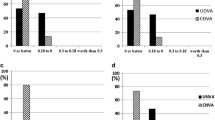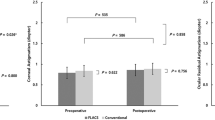Abstract
Background
Microincisional cataract surgery is a safe procedure with a very short learning period for an experienced cataract surgeon and rollable ultrathin intraocular lenses eliminate the need for enlargement of corneal incision. The purpose of the study was to evaluate the safety and efficacy of cataract surgery through a corneal microincision and implantation of rollable ultrathin intraocular lenses. The setting was Dokuz Eylul University Medical Faculty, Ophthalmology Department, Izmir, Turkey and SSK Okmeydani Hospital, Ophthalmology Clinic, Istanbul, Turkey.
Patients and methods
Ninety eyes in 85 patients were operated on through clear corneal microincisions with sleeveless phacoemulsification and rollable intraocular lenses were implanted. Forty-six of the patients were men and 39 were women between the ages of 27 and 83, with a mean of 51 years. Two eyes had atrophic senile macular degeneration, 4 eyes had nonspecific retinal pigment epithelial changes with chorioretinal atrophy, and 4 patients had diabetes mellitus without retinopathy. Three eyes had posterior capsular opacifications of unknown etiology. Two eyes had primary open angle glaucoma (PAAG) with cup to disc ratios of about 0.5. Three eyes had dense nuclear sclerosis of grade 4 with very low visibility of retinal structures. Other patients had no ocular or systemic pathology other than nuclear/corticonuclear cataract of grade 2–3. Uncorrected and best spectacle-corrected distance and near visual acuities, keratometric values, and refractive status were noted preoperatively and 1 week, 1 month, and 6 months postoperatively. Statistical analysis of keratometric changes between preoperative and postoperative findings was performed using the paired samples t test.
Results
At 6 months postoperatively, 1 patient had a best spectacle-corrected visual acuity (BSCVA) of 0.2, the patient with atrophic senile macular degeneration. The rest of the eyes achieved a BSCVA of 0.63 or better. At 6 months postoperatively, 55 (61.11%) eyes had uncorrected visual acuities (UCVA) equal to or better than 0.8 and 83 (92.22%) eyes had BSCVA equal to or better than 0.8 according to the Snellen chart. The mean postoperative corneal astigmatisms at 1 week, 1 month, and 6 months were 0.69±0.43 D, 0.66±0.46 D and 0.65±0.48 D respectively. Statistical analysis revealed a significant change in corneal astigmatisms at the 1st week visit (p<0.05), but not at the 1st and 6th month visits (p>0.05) compared with preoperative findings.
Conclusion
Based on the limited data in the literature and in this study, it is not possible to make concrete decisions about the benefits and disadvantages of the ThinOptx IOL for longer durations. Intraoperatively, this IOL apparently eliminates the need for enlargement of the corneal incision during implantation. However, the statistical insignificance of induced astigmatisms after microincisions and classical phacoincisions should also be taken into consideration. We conclude that ThinOptx IOL is a pioneering intraocular lens implant that will contribute to the exciting future of cataract refractive surgical procedures. However, both clinical and laboratory investigations are needed to clearly describe the long-term effectiveness of this new rollable IOL.






Similar content being viewed by others
References
Alio JL, Prats JLR, Galal A (2004) MICS: microincisional cataract surgery. Highlights of Ophthalmology, Panama
Apple DJ, Auffahrt GU, Peng Q, Visessook N (2000) Foldable intraocular lenses: evolution, clinicopathologic correlations, complications. Slak, Thorofare
Auer C, Gonvers M (1995) Silicone one piece intraocular lens implant and anterior lens capsule fibrosis. Klin Monatsbl Augenheilkd 206:293–295
Dogru M, Honda R, Omoto M, Fujishima H, Yagi Y, Tsubota K, Kojima T, Matsuyama M, Nishijima S, Yagi Y (2004) Early visual results with the rollable ThinOptx intraocular lens. J Cataract Refract Surg 30:558–565; erratum in: J Cataract Refract Surg 30:1154
El-Maghraby A, Anwar M, el-Sayyad F, Matheen M, Marzouky A, Gazayerli E, Salah T, Ballew C (1993) Effect of incision size on early postoperative visual rehabilitation after cataract surgery and intraocular lens implantation. J Cataract Refract Surg 19:494–498
Fine IH, Packer M, Hoffman RS (2002) New phacoemulsification technologies. J Cataract Refract Surg 28:1054–1060
Gills JP (2002) Treating astigmatism at the time of cataract surgery. Curr Opin Ophthalmol 13:2–6
Gimbel HV, Neuhann T (1990) Development, advantages and methods of the continuous circular capsulorhexis technique. J Cataract Refract Surg 16:31–37
Grabow HB (1993) Topical anesthesia for cataract surgery. Eur J Implant Ref Surg 5:200–201
Hoffer KJ (1993) The Hoffer Q formula: a comparison of theoretical and regression formulas. J Cataract Refract Surg 19:700–712
Holladay JT, Prager TC, Ruiz RS, Lewis JW, Rosenthal H (1986) Improving the predictability of intraocular lens power calculations. Arch Ophthalmol 104:539–541
Kohnen T, Dick B, Jakobi KW (1995) Comparison of the induced astigmatism after temporal clear corneal tunnel incisions of different sizes. J Cataract Refract Surg 21:417–424
Linebarger EJ, Hardten DR, Shah GK, Lindstrom RL (1999) Phacoemulsification and modern cataract surgery. Surv Ophthalmol 44:123–147
Nishi O, Nishi K, Mano C, Ichihara M, Honda T (1998) Lens refilling with injectable silicone in rabbit eyes. J Cataract Refract Surg 24:975–982
Pandey SK, Werner L, Agarwal A, Agarwal A, Lal V, Patel N, Hoyos JE, Callahan JS, Callahan JD (2002) Phakonit: cataract removal through a sub-1.0 mm incision and implantation of the ThinOptx rollable intraocular lens. J Cataract Refract Surg 28:1710–1713
Retzlaff JA, Sanders DR, Kraff MC (1990) Development of the SRK-T intraocular lens implant power calculation formula. J Cataract Refract Surg 16:333–340; erratum: J Cataract Refract Surg 16:528
Sanders DR, Retzlaff JA, Kraff MC (1998) Comparison of SRK II formula and other second generation formulas. J Cataract Refract Surg 14:136–141
Subramaniam S, Tuft SJ (2001) Early decentration of plate haptic silicone intraocular lenses. J Cataract Refract Surg 27:330–332
Author information
Authors and Affiliations
Corresponding author
Additional information
Authors do not have any proprietary interest in any of the materials mentioned in the text
This study did not receive any public or private funding
This study has been performed in accordance with the ethical standards laid down in the 1964 Declaration of Helsinki
Rights and permissions
About this article
Cite this article
Cinhüseyinoglu, N., Celik, L., Yaman, A. et al. Microincisional cataract surgery and Thinoptx rollable intraocular lens implantation. Graefe's Arch Clin Exp Ophthalmo 244, 802–807 (2006). https://doi.org/10.1007/s00417-005-0158-5
Received:
Revised:
Accepted:
Published:
Issue Date:
DOI: https://doi.org/10.1007/s00417-005-0158-5




